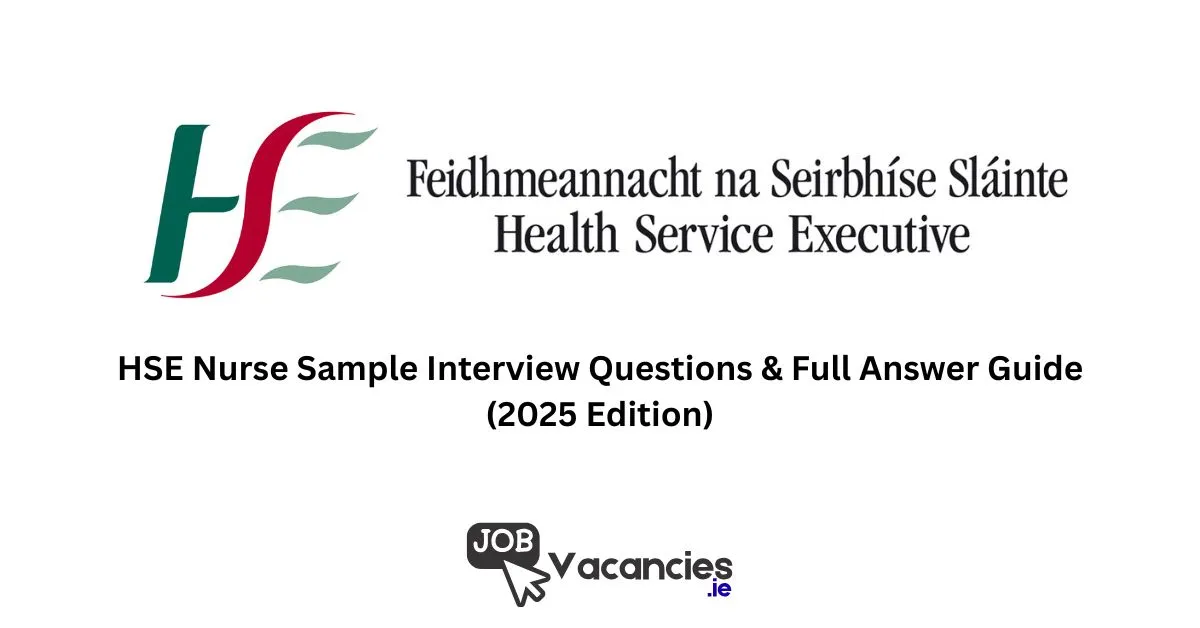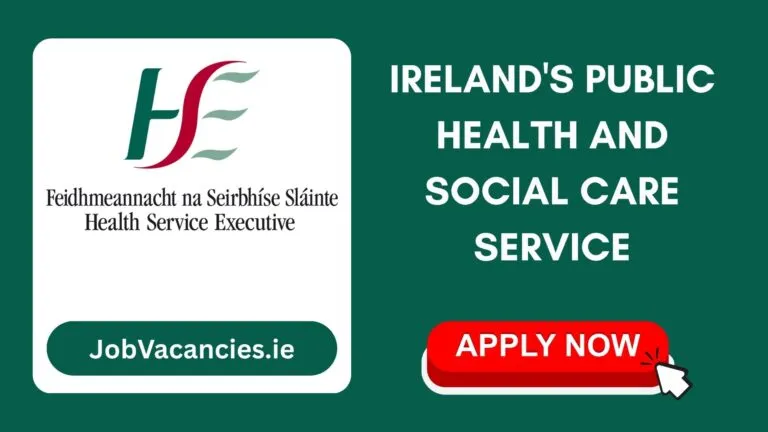This guide is designed for nurses interviewing for HSE posts such as Staff Nurse, Public Health Nurse, or CNM1 roles.
It reflects HSE values — Care, Compassion, Trust, and Learning — and NMBI professional standards.
🩺 SECTION 1: General & Core HSE Questions
1. Tell us about yourself and why you want to work for the HSE.
Example Answer:
“I’m a Registered General Nurse with over four years of experience in acute hospital care. I’m passionate about providing evidence-based, compassionate nursing to all patients, regardless of background.
I want to work for the HSE because of its strong commitment to equitable healthcare and continuous improvement. The organisation’s focus on learning and collaboration aligns with my own values — I believe in delivering safe, person-centred care and constantly developing my professional skills.”
2. How do you ensure high-quality patient care in your daily practice?
Example Answer:
“I ensure high-quality care through careful assessment, planning, and evaluation of each patient’s needs. I follow the nursing process, maintain accurate documentation, and always communicate clearly with the multidisciplinary team.
For example, on my last ward, I noticed patients with mobility issues had a higher incidence of pressure ulcers. I initiated a repositioning chart system and liaised with the tissue viability nurse. Within weeks, incidents decreased significantly, demonstrating the value of proactive, evidence-based practice.”
3. Describe a time you worked effectively in a multidisciplinary team.
Example Answer:
“In a rehabilitation ward, I worked with physiotherapists, occupational therapists, and dietitians to help a stroke patient regain mobility. My role was to monitor vital signs, administer medications, and reinforce rehabilitation exercises. Through daily team meetings, we shared updates and adapted care plans.
The patient’s progress improved, and they were discharged independently. This experience reinforced that teamwork and communication are vital for positive patient outcomes.”
⚕️ SECTION 2: Clinical Competency Questions
4. How do you maintain safe medication administration practices?
Example Answer:
“I adhere strictly to the ‘ten rights’ of medication administration — Right patient, Right reason, Right medication, Right route, Right time, Right dose, Right form, Right action, Right documentation, and Right response. I check allergies, follow the double-check system for high-risk medications, and report any discrepancies immediately. Once, I noticed a transcription error on a MAR chart. I clarified it with the prescriber before administration, preventing a potential medication error. This highlights the importance of vigilance and accountability in nursing.”
5. What steps do you take to prevent infection in the clinical setting?
Example Answer:
“I follow all HSE infection prevention and control (IPC) guidelines, including hand hygiene, use of PPE, aseptic technique, and waste segregation. I also ensure patient areas are cleaned and equipment is decontaminated between uses.
During the flu season, I helped reinforce mask compliance on the ward and updated isolation signage, which reduced cross-infection rates. Infection control is everyone’s responsibility, and I always lead by example.”
6. How do you manage the care of a deteriorating patient?
Example Answer:
“If a patient’s condition begins to deteriorate, I assess using the ABCDE approach and take vital signs immediately. I escalate concerns according to the HSE’s Early Warning Score (EWS) protocol.
In one case, a patient’s respiratory rate suddenly increased. I escalated to the registrar, initiated oxygen therapy, and stayed with the patient until the medical team arrived. Prompt recognition and escalation are essential for patient safety.”
💬 SECTION 3: Patient-Centred Care Questions
7. How do you involve patients and families in care planning?
Example Answer:
“I encourage open communication and ensure patients understand their diagnosis and treatment options. I involve families when appropriate, respecting patient consent.
For example, when caring for a diabetic patient struggling with dietary changes, I arranged for a dietitian consultation and included the patient’s spouse in the discussion. This improved adherence and confidence in self-care.”
8. Describe a time you advocated for a patient’s needs.
Example Answer:
“I once cared for an elderly patient who was in severe pain despite regular analgesia. I contacted the medical team to reassess pain management and advocated for a stronger regime. After adjustments, the patient’s comfort improved significantly.
Advocacy means ensuring the patient’s voice is heard — especially when they may not be able to speak up for themselves.”
⚖️ SECTION 4: Ethical & Professional Standards Questions
9. How would you respond if you witnessed unsafe or unprofessional practice?
Example Answer:
“I would intervene immediately if patient safety was at risk. I’d address the issue calmly and respectfully, ensure any immediate danger is removed, and then report it to my line manager.
I would document the incident objectively and follow the HSE’s ‘Open Disclosure’ and incident reporting policy. Accountability and integrity are key to maintaining professional standards and public trust.”
10. How do you maintain your professional competence as a registered nurse?
Example Answer:
“I actively maintain my NMBI registration and complete annual CPD hours. I attend in-service training, read clinical updates, and participate in reflective practice.
Recently, I completed a course in pressure injury prevention, which led me to update our ward’s turning schedule. Continuous learning helps ensure that the care I provide is safe, current, and evidence-based.”
🧠 SECTION 5: Scenario-Based Questions
Scenario 1 – Deteriorating Patient
A patient becomes short of breath and their oxygen saturation drops to 86%. What do you do?
Example Answer:
“I’d assess airway and breathing immediately, raise the head of the bed, administer oxygen as prescribed, and call for assistance. I’d record vital signs, use the EWS chart, and escalate to the medical team. While waiting, I’d stay with the patient, reassure them, and prepare emergency equipment. Documentation and follow-up are essential once the situation is stabilised.”
Scenario 2 – Family Complaint
A patient’s relative is angry and says their loved one is being ignored. How do you handle it?
Example Answer:
“I’d invite the family member to a private area, listen without interruption, and acknowledge their concerns. I’d clarify facts, apologise if appropriate, and explain what steps I’ll take to address the issue. Then I’d check on the patient and ensure their needs are met. Communication and empathy usually defuse tension and rebuild trust.”
Scenario 3 – Short Staffing
You are working on a ward that is short-staffed. How do you maintain patient safety?
Example Answer:
“I would prioritise care based on patient acuity, delegate tasks appropriately to healthcare assistants, and inform the nurse manager of the staffing situation. I’d focus on essential nursing duties such as medication administration, monitoring, and safety checks. I’d also maintain teamwork and communication throughout the shift to ensure continuity of care.”
Scenario 4 – Confidentiality Concern
A colleague discusses a patient’s case in a public area. What would you do?
Example Answer:
“I’d discreetly remind my colleague about confidentiality and suggest we continue the discussion in a private area. Afterwards, I’d reflect on whether further guidance is needed and, if appropriate, inform the line manager. Maintaining confidentiality is a professional obligation under the NMBI Code of Conduct.”
🧭 Final Interview Preparation Tips
✅ Use the STAR method: Structure your answers around Situation, Task, Action, and Result.
✅ Know the HSE Core Values: Care – Compassion – Trust – Learning.
✅ Review NMBI Standards: Scope of Practice and Code of Professional Conduct.
✅ Bring documentation: NMBI PIN, CV, certifications, and ID.
✅ Ask a question at the end: e.g. “How does the HSE support ongoing professional development for nurses?”





